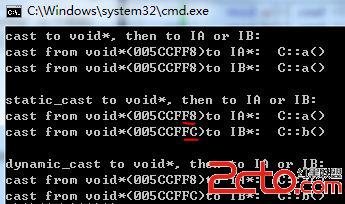C++支持多重繼承,然而多重繼承可能會導致一些奇怪的問題,我前段時間遇到一個指針轉換問題,非常典型。
先看一個簡單的測試代碼:
#include
using namespace std;
class IA
{
public:
virtual ~IA(){}
virtual void a() = 0;
};
class IB
{
public:
virtual ~IB(){}
virtual void b() = 0;
};
class CMulti : public IA, public IB
{
public:
CMulti(){}
~CMulti(){}
void a(){ cout << "C::a()" << endl; }
void b(){ cout << "C::b()" << endl; }
};
void testCastA(void *p)
{
cout << "cast from void*(" << p << ")to IA*: ";
IA *a = (IA *)p;
a->a();
}
void testCastB(void *p)
{
cout << "cast from void*(" << p << ")to IB*: ";
IB *b = (IB *)p;
b->b();
}
int _tmain(int argc, _TCHAR* argv[])
{
CMulti * c = new CMulti;
cout << "cast to void*, then to IA or IB:" << endl;
testCastA((void*)c);
testCastB((void*)c);
cout << endl;
cout << "static_cast to void*, then to IA or IB:" << endl;
testCastA((void*)static_cast(c));
testCastB((void*)static_cast(c));
cout << endl;
cout << "dynamic_cast to void*, then to IA or IB:" << endl;
testCastA((void*)dynamic_cast(c));
testCastB((void*)dynamic_cast(c));
return 0;
}
我測試了:
強制轉換為void* 先static_cast再強制轉換為void* 先dynamic_cast再強制轉換為void*(32位程序)運行的結果如下圖所示:

差異很明顯了,結論也很明了:多重繼承時,子類指針轉換為非第一繼承的父類指針時,會發生地址偏移(注意圖上標紅的部分)。這是因為每一個父類都會占用 4 個字節維護自己的虛函數表。所以,當 CMulti* 轉換為 IB* 時,指針加 4 ,因為 IA 是 CMulti 的第一父類, IB 是第二父類,依次類推……
如果我們在某些地方不得不使用 void* 來進行代碼適配時,遇到多重繼承就要注意這一點,否則很可能你調用的是 b() 方法,實際執行的是 a() ,達不到預期效果。